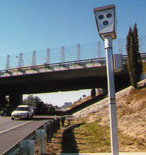7/20/2007
Australia: Police Admit Average Speed Camera ErrorPolice in Victoria, Australia admit a point-to-point speed camera issued an inaccurate ticket.

An Australian bus driver was vindicated this week when Victoria Police admitted their expensive new average speed camera system should not have issued the man a ticket in April. The systems, known as SPECS in England or point-to-point in Australia represent the latest development in automated ticketing. Instead of using sensors, lasers or radar, the devices photograph vehicles as they pass between two camera stations. The device makes an estimate of vehicle speed from the amount of time it takes for photographed vehicles to pass between both locations.
That's the theory. In practice, the device accused a bus belonging to Seymour Coaches of driving 123km/h (76 MPH) in a 110km/h (68 MPH) zone on the Hume Highway near Melbourne. Such a conviction, besides the A$250 fine, can have serious negative consequences for a commercial driver. Identified only as Warren, the driver knew he had not been speeding, despite the police claim, because his bus was fitted with a speed limiter. Government inspectors in December had verified that the limiter prevented the bus from exceeding 100km/h (62 MPH).
Victoria Police Superintendent Shane Patton told the Australian Associated Press that "human error" caused the ticket because two similar buses with similar plates were traveling on the road at the same time, confusing the camera system. Patton blamed the ticket on human supervisors who are supposed to verify the automated ticketing process.
Speed cameras have a history of errors on Australian roads with millions worth of tickets refunded in the past four years. On the Hume Highway alone, 303 faulty tickets were issued on March 23, 2004. Another 119 innocent motorists were ticketed on July 21, 2005.


